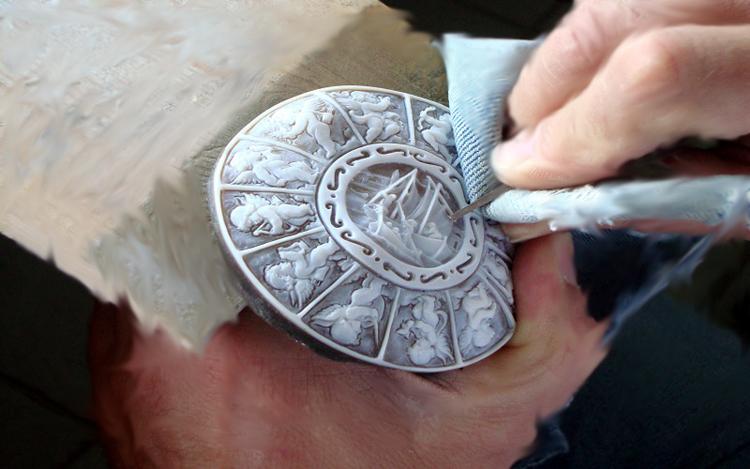“I am the heir of a very ancient art,” Marco Jovon said proudly as he showed me the product of his art: beautiful handmade cameos.
For those of you not familiar, the dictionary definition of a cameo is “a piece of jewelry that has a carved design shown against a background of a different color.” But, as Jovon demonstrated, it is so much more than that.
It is craftsmanship, first and foremost. Not just general craftsmanship, but rather Italian craftsmanship - that combination of creativity, artisanal skill and love for beauty summarized by the world-famous Made in Italy brand. “When we talk about cameos, we mostly refer to a certain type of workmanship rather than a product,” Jovon writes in The Cameos, an e-book he authored about the art of cameo-making.
It is art, of course: “a work of art imprisoned by too much raw material.” Drawing on a comparison with what Michelangelo had said of sculpting, Jovon explains that “when a real artist holds a material in his hands, be it shell, coral, stone or else, he already sees the cameo inside. All he has to do is to set it free.”
And it is love – love at first sight. The cameo you should buy is “the cameo you love the very moment you see it,” writes Jovon. “Every cameo sends a calling to only one person. If this person can hear the calling, he/she will be totally fascinated and will fall in love with it.”
Eredi Jovon: heirs of Venetian craftsmanship

[The Jovon family - from left to right: Marco, mamma Gabriella, Alessio.]
I learned about the art of cameo-making on a recent trip to Venice, during which I had the pleasure to meet Marco Jovon and his mother Gabriella. After only a few minutes of hearing them talk about cameos, it was clear how much enthusiasm and passion they put into their craft – these are people who love what they do, and want to share their love with others.
Jovon, along with his brother Alessio and their mother Gabriella, carry on the tradition and business inherited by his father Bruno and grandfather Luciano, the original founder of the family business in 1934, who set up shop on the Rialto Bridge in Venice, quickly establishing it as one of the leading cameo-making workshops in the city. They call it “Eredi Jovon” to highlight the pride and importance of their family heritage.
History of cameos
Some historians believe the word ‘cameo’ derives from the Arabic ‘kamea’, meaning charm or amulet; others think the Latin root of the word ‘cameo’ means ‘to engrave’. What is sure is that cameos have been around for a very long time, with their major development during the Roman empire. In fact, one of the most famous cameos is the Blacas Cameo, a large ancient Roman cameo, carved from a piece of sardonyx showing the profile head of Roman emperor Augustus; it probably dates from shortly after his death in AD 14 (it is now preserved in the British Museum in London). Other famous cameos from Roman times include the Gemma Augustea, a low-relief cameo cut from a double-layered Arabian onyx stone, and the Gemma Claudia, a five-layered onyx cameo.
While cameos became less common during the Middle Ages, they saw a revival during the Renaissance, with powerful Italian families such as the Medicis and the Gonzagas being avid cameo collectors, and also during the Victorian era in England.
Today, cameos are made into fine pieces of jewelry: from necklaces to pendants, from bracelets to earrings to rings. Subjects vary widely and can be inspired by nature, art, people, animals. You could even choose your own portrait subject: Eredi Jovon specializes in custom-made cameos, which they can craft from a simple photo of the subject.

The fine art of cameo-making
Perhaps most important than the technical aspects, cameo-making requires patience and an eye for detail. The process begins with the choice of the material: most cameos are engraved in shells (cornelian and sardonyx are two classic ones). Other materials include stone, coral, turquoise, lavic stone and agate. Unfortunately, cameos can be made with plastic and resins too – according to Jovon, these are actually the majority found on the market; they are low quality and cost a few euros, are mass- produced and have nothing to do with the real artistic cameo, which is always a unique piece.
Once the material has been chosen, it will then be cut, at times given a shape, then rounded and placed on a support for the artist to lean on a flat surface while engraving. A drawing is made before the engraving starts; engraving is the most creative and delicate phase of cameo-making. Finally, the cameo is mounted or framed according to what it will become: a pendant perhaps, a ring, or a brooch. Beware of cameos whose mounting appears very sophisticated, says Jovon: this is often to distract you from the cameo itself, to conceal its poor quality and the fact that it is made of plastic.

“Nothing is casual,” says Jovon. “In a high-quality cameo, you can see the skilled hand of a gifted artist aiming at both quality and three-dimensionality.”
I was not really aware of this art before traveling to Venice and meeting Jovon; but hearing and reading about it, and seeing it for myself, has taught me about another example of great Italian craftsmanship. I was even lucky enough to receive my own cameo pendant with my initials engraved on it. Now when I wear it, I am well aware of the love and skills that have produced it, and this indeed gives it an added value. It is unique. It is Italian.
Photos courtesy of Eredi Jovon.
Eredi Jovon is located at Ponte di Rialto, 5325 San Marco, Venice.










